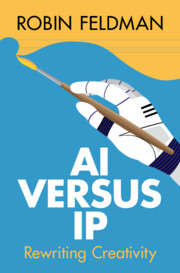
-
Select format
-
- Publisher:
- Cambridge University Press
- Publication date:
- August 2025
- August 2025
- ISBN:
- 9781009646833
- 9781009646864
- 9781009646840
- Dimensions:
- (229 x 152 mm)
- Weight & Pages:
- 0.485kg, 228 Pages
- Dimensions:
- (229 x 152 mm)
- Weight & Pages:
- 0.34kg, 228 Pages
You may already have access via personal or institutional login
Book description
The rise of artificial intelligence is challenging the foundations of intellectual property. In AI versus IP: Rewriting Creativity, science writer Robin Feldman offers a balanced perspective as she explains how artificial intelligence (AI) threatens to erode all of intellectual property (IP) – patents, trademarks, copyrights, trade secrets, and rights of publicity. Using analogies to the Bridgerton fantasy series and the Good Housekeeping 'Seal of Approval,' Professor Feldman also offers solutions to ensure a peaceful coexistence between AI and IP. And if you've ever wanted to understand just how modern AI programs like ChatGPT, Claude, Gemini, Grok, Meta AI, and others work, AI versus IP: Rewriting Creativity explains it all in simple language, no math required. AI and IP can coexist, Feldman argues, but only if we fully understand them and only with considerable effort and forethought.
Contents
Metrics
Altmetric attention score
Full text views
Full text views help Loading metrics...
Loading metrics...
* Views captured on Cambridge Core between #date#. This data will be updated every 24 hours.
Usage data cannot currently be displayed.
Accessibility standard: WCAG 2.0 AAA
Why this information is here
This section outlines the accessibility features of this content - including support for screen readers, full keyboard navigation and high-contrast display options. This may not be relevant for you.
Accessibility Information
The PDF of this book conforms to version 2.0 of the Web Content Accessibility Guidelines (WCAG), ensuring core accessibility principles are addressed and attains the highest (AAA) level of WCAG compliance, optimising the user experience by meeting the most extensive accessibility guidelines.
Content Navigation
Table of contents navigation
Allows you to navigate directly to chapters, sections, or non‐text items through a linked table of contents, reducing the need for extensive scrolling.
Index navigation
Provides an interactive index, letting you go straight to where a term or subject appears in the text without manual searching.
Reading Order and Textual Equivalents
Single logical reading order
You will encounter all content (including footnotes, captions, etc.) in a clear, sequential flow, making it easier to follow with assistive tools like screen readers.
Short alternative textual descriptions
You get concise descriptions (for images, charts, or media clips), ensuring you do not miss crucial information when visual or audio elements are not accessible.
Full alternative textual descriptions
You get more than just short alt text: you have comprehensive text equivalents, transcripts, captions, or audio descriptions for substantial non‐text content, which is especially helpful for complex visuals or multimedia.
Visual Accessibility
Use of colour is not sole means of conveying information
You will still understand key ideas or prompts without relying solely on colour, which is especially helpful if you have colour vision deficiencies.
Use of high contrast between text and background colour
You benefit from high‐contrast text, which improves legibility if you have low vision or if you are reading in less‐than‐ideal lighting conditions.

